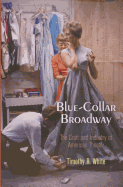
Historian Timothy R. White considers an unexamined intersection of urban history and theater history in Blue-Collar Broadway: The Craft and Industry of American Theater. Broadway as his subject is both a geographical area in New York City and a representation of theater in the United States; his focus is the crafts and trades that have supported Broadway in both its meanings over the years.
As White shows, for every singing, dancing actor who treads the boards, myriad supporting players are necessary. Stagecraft covers the craftspeople (carpenters, painters, seamstresses, milliners, costumers and designers) who produce the backdrops, painted scenery, furniture, drapes, props, costumes, wigs and makeup, working with a variety of raw materials, including lumber, paint, fabric. Later in history, lighting and sound riggers and technicians joined this list (in fact, the arrival of electric lighting prompted improvements in costumes and scenery, since they could now be seen clearly). These craftspeople were then challenged by the ascension of alternate media (radio and, to a lesser extent, film and television) to find new roles.
Blue-Collar Broadway details these trades, their history and their products, and the industrialization and unionization that came with the concentration of theater in New York City's Broadway district. He also offers new explanations for patterns of crime and prostitution in Times Square's recent past, using the context of theater craft. His voice is academic and no-nonsense; any fan of theater history, economics, the patterns of New York City or general urban history will find his meticulous research stimulating. --Julia Jenkins, librarian and blogger at pagesofjulia

